
Charlestown, Maryland
Canon 5D ©falmanac 2006





Long time Baltimore water supply and Sunday drive venue, Loch Raven Dam has gotten a make-over. The dam received significant reinforcement including an impressive looking storm gate that will close off the road during major catastrophes. I remember reading that the city wasn't happy about having to do the project (federally mandated & not inexpensive), but speaking as a down-streamer, I'm glad they did. For more info on the project click here.
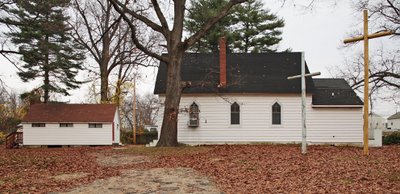
 "In 1917 Harford's decades of sunny, prosperous, and seemingly unending tranquility were abruptly interrupted by America's entry into World War I. Many Countians volunteered for and saw service in Europe during the conflict, it seems arguable that the greatest affect the Great War had on Harford came in October 1917, when the federal government condemned the entire Gunpowder and Bush river necks -35,211 acres of land and 34,000 acres covered by water or about 60 square miles in all. Heretofore, as historian Keir Stirling has written, these stretches of southern Harford County "were locally known as the 'Garden of Eden,' where an excellent grade of shoe peg corn had been grown for many years. Many area farmers were able to produce 125 bushels of corn to the acre. The Baker family and others engaged in the profitable canning industry were producing about 300,000 cases of shoe peg corn and tomatoes worth approximately $1.5 million annually by 1917 .... The famous Poole's Island peaches were ... were canned locally and considered to be of high quality. Local fishing was another industry worth $700,000 a year."
"In 1917 Harford's decades of sunny, prosperous, and seemingly unending tranquility were abruptly interrupted by America's entry into World War I. Many Countians volunteered for and saw service in Europe during the conflict, it seems arguable that the greatest affect the Great War had on Harford came in October 1917, when the federal government condemned the entire Gunpowder and Bush river necks -35,211 acres of land and 34,000 acres covered by water or about 60 square miles in all. Heretofore, as historian Keir Stirling has written, these stretches of southern Harford County "were locally known as the 'Garden of Eden,' where an excellent grade of shoe peg corn had been grown for many years. Many area farmers were able to produce 125 bushels of corn to the acre. The Baker family and others engaged in the profitable canning industry were producing about 300,000 cases of shoe peg corn and tomatoes worth approximately $1.5 million annually by 1917 .... The famous Poole's Island peaches were ... were canned locally and considered to be of high quality. Local fishing was another industry worth $700,000 a year."
Overnight all this changed as everyone living on those bay-front lands had to move to make way for the poison-gas testing facilities Washington felt the war demanded. The former landowners - the Cadwaladers, Bakers, Mitchells, and others - received some payment from the government for their lost acres and many of them then purchased other farms and resumed their lives. The workers, generally black tenant farmers, received nothing and were forced to move from the source of their livelihoods. Many such displaced families, including the Dembys and Gilberts, settled in a stretch of land near Magnolia; the houses, church, and school they built created the community now called Dembytown (HA-1603, HA-1604)." From the 1998 Historical Preservation Element.
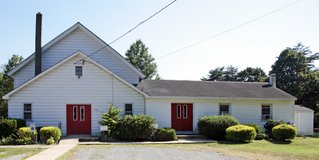
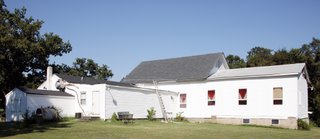
Saint James African Methodist Episcopal Church of Gravel Hill, Maryland can trace its history all the way back to emancipation days and beyond. (This is how I write when I've misplaced my notes - vaguely!) The community of Gravel Hill (near Havre de Grace in Harford County) sent many of its sons off to fight for the Union and many of them are buried at Saint James. I love the church building; while it sprawls in the back, the front presents an unostentatious appearance for a building of such historic importance. It's refreshing to know that Christian modesty hasn't been entirely abandoned here in the US of A.
"If something is faintly not nice, humans retreat into a fog of euphemism that merely hints at meaning, as if the words themselves were at fault. Consider the privy, which in the eighteenth century was called the necessary house or, more simply, the necessary. This little structure—of brick or wood, painted or unpainted, of vernacular or high-style design—was also known as a bog, boghouse, boggard, or bog-shop; a temple, a convenience, or temple of convenience; a little house, house of office, or close stool; a privy or a garde-robe, terms that descend from the Middle Ages. Or a jakes, a sixteenth-century term. Williamsburg’s St. George Tucker once defined a jakes as a garden temple." Read on.
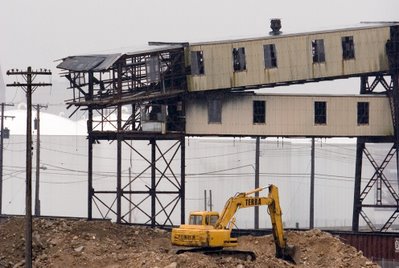
In 2001 Baltimore's last functioning grain pier collapsed into the harbor. Oddly enough, nobody cared enough to restore it, or build a new facility, not ADM, not CSX, not the Port of Baltimore. This left a lot of local farmers out in the cold. Fortunately a new grain transfer facility is being proposed for Havre de Grace along Norfolk Southern's "Old Bay Line." The old Baltimore facility, in Locust Point, is being converted into condos.
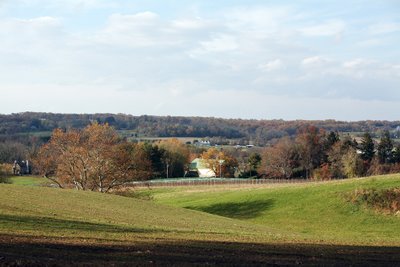
The Long Green Valley, just a few miles north of Baltimore, isn't very long at all, but it is very green, and quite pleasing to the eye as well. It may be the best looking acreage in Maryland, and for my money, one of the best looking places in the world.
The valley remains largely as it was 50 or a hundred years ago. The railroad is gone and there's a few McMansions littering the hills, but besides for that, it hasn't changed much.
Nothing big ever happened in the valley, just people living their lives over the centuries, no Antietams, no "Washington Slept Here," no Appomatti.
 Edward Hill Dorsey Pue, of Bel Air, Maryland, was wounded on eleven separate occasions during the Civil War. It reminds me of a quote by Oscar Wilde, "To lose one parent may be regarded as a misfortune; to lose both looks like carelessness." The man must have been almost absurdly dogged. In spite of it all, he survived the war to live another four decades. He is buried at Saint Mary's in Emmorton, Maryland.
Edward Hill Dorsey Pue, of Bel Air, Maryland, was wounded on eleven separate occasions during the Civil War. It reminds me of a quote by Oscar Wilde, "To lose one parent may be regarded as a misfortune; to lose both looks like carelessness." The man must have been almost absurdly dogged. In spite of it all, he survived the war to live another four decades. He is buried at Saint Mary's in Emmorton, Maryland.